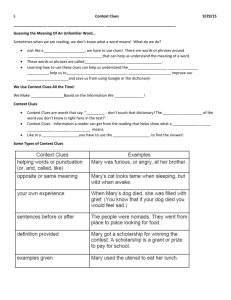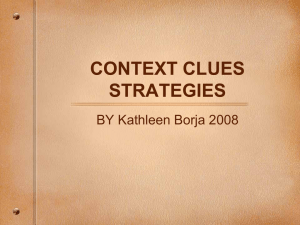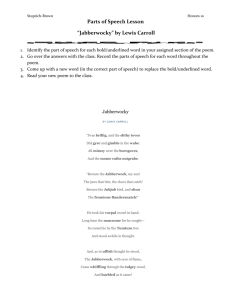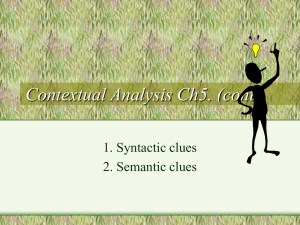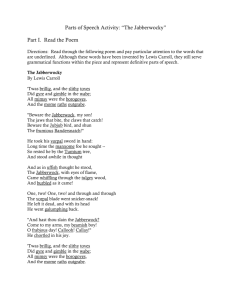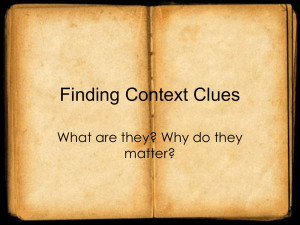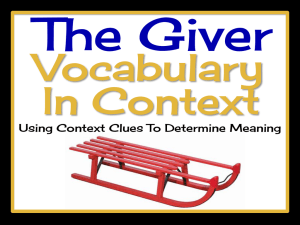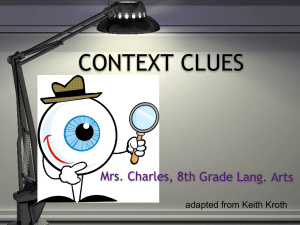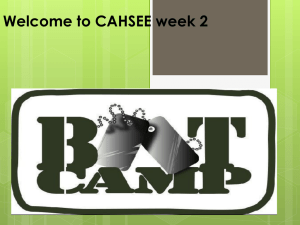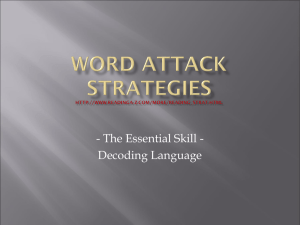Context Clue Powerpoint
advertisement
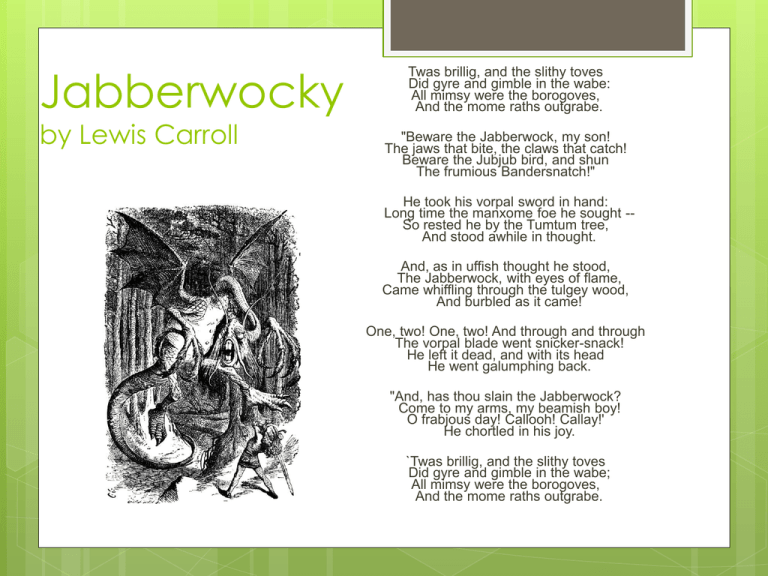
Jabberwocky by Lewis Carroll Twas brillig, and the slithy toves Did gyre and gimble in the wabe: All mimsy were the borogoves, And the mome raths outgrabe. "Beware the Jabberwock, my son! The jaws that bite, the claws that catch! Beware the Jubjub bird, and shun The frumious Bandersnatch!" He took his vorpal sword in hand: Long time the manxome foe he sought -So rested he by the Tumtum tree, And stood awhile in thought. And, as in uffish thought he stood, The Jabberwock, with eyes of flame, Came whiffling through the tulgey wood, And burbled as it came! One, two! One, two! And through and through The vorpal blade went snicker-snack! He left it dead, and with its head He went galumphing back. "And, has thou slain the Jabberwock? Come to my arms, my beamish boy! O frabjous day! Callooh! Callay!' He chortled in his joy. `Twas brillig, and the slithy toves Did gyre and gimble in the wabe; All mimsy were the borogoves, And the mome raths outgrabe. Are you confused yet??? “No need to reach for the dictionary. There are clues right there in the text! Be a detective!" Context Clues Words or phrases around an unfamiliar word which can help you understand the meaning of this new word are called context clues. If you learn how to use these clues, you can save yourself a trip to the dictionary, increase your vocabulary, and improve your reading comprehension. Context Clues Vocabulary knowledge is mandatory to achieve success. Often when confronted with an unfamiliar word within its context, students will skip over it and continue to read, or they will stop reading altogether. Next time you are taking a test and come across a word you do not know – don’t despair – context clues can provide you with the clues you need to figure out new word meanings. Context Clues The sentence might offer an example of the word or tell what the word does. If you encounter an unfamiliar word, context clues or other words around it in the sentence or paragraph can help you figure out its meaning. 1. Definitions may be right there in the sentence … After the word or that directly follow the unfamiliar word. Example: The trek, or journey, became more challenging as we approached the top of the mountain. 2. Punctuation may lead you in the right direction … Authors often use punctuation clues to help the reader. Punctuation clues might include commas, dashes, or parentheses. Example: In order to keep the dogs inside the yard, we built a parapet, a low wall or railing. 2. More Examples John retained, kept, all the letters his wife had written him. I wonder if that fruit is edible, able to be eaten. The school is going through many transitions, changes. Children are often loquacious, very talkative and active. Bigamy, marriage to two spouses at the same time, is not legal in the United States. 3. Definitions may come first … Context clues may be listed at the beginning of the sentence before the unfamiliar word. Example: The worm ate the middle layer of the peach, which is called the mesocarp. 4. Clues can be found elsewhere in the passage … In the previous sentence. Example: Everyone at the dinner table cleaned their plates and asked for seconds. As the guests left, they said the dinner was delectable. 5. Another example … In the next sentence following the word Example: Jake left the waitress a paltry tip. She forgot to give them glasses of water, brought out cold food, and never checked on them, so she deserved a small tip. 6. Make predictions based on information in the text … By replacing the unfamiliar word with a “prediction” word to see if it fits or makes sense. Example: He acted like a buffoon at the party by telling jokes and laughing too loudly and too often. (prediction word: fool) 7. Look for familiar word parts … By studying the unfamiliar word’s prefix, suffix, or root word and writing the meanings to figure out the meaning of the word. Example: The only part of the city recognizable to Ian was the Sears Tower. (-able=capable of being recognized) 8. Are the clues negative or positive … By asking yourself if the word sounds positive or negative. Example: The evil stepmother cast a sinister glare at the Cinderella when she asked her a question. (evil=negative) 9. Do you recognize the part of speech … By figuring out the word’s part of speech, such as a noun, verb, adjective, or adverb. Example: He guzzled water rapidly after the race. (Guzzled is a verb. Recognize that –ed ending? He did something to the water.) 10. Look for synonyms and antonyms … The context clue may be a synonym (words with almost the same meaning) or an antonym (words opposite in meaning) for the unfamiliar word. Examples: Reducing cholesterol has a number of advantageous results. One positive outcome is reducing the risk of heart disease. (synonym clue) I detest liver, but I adore steak. (antonym clue) Practice 1 I have always lived in cubbyholes. After moving away from home, my first apartment was just a cubbyhole in a large building. It was no more that 8' by 12' and had a bed in one corner. My second was no more than a large walk-in closet. My current one is about 10 feet long by 12 feet wide, but it at least has two rooms. Possible Answer: A. Small space B. Large Space C. Home Practice 2 The floors of the restaurant were extremely soiled. They were covered with spilled grease, crumbs of food, and cigarette butts. Possible Answer: A. Clean B Dirty C. Straight Practice 3 The contractor was always well remunerated for his work. For example, he received $10,000 for a small addition to a house and last year he was received $5,000 for reconstructing a stairway. Possible Answer: A. Valued B. Given C. Paid Practice 4 The department store carries a variety of dungarees, for example they carried Levis, Wranglers, and even some plain unlabeled brands made of cotton. Possible Answer: A Clothes B. Pants C. Socks Practice 5 Josie received a bauble for a present from her great aunt. This she put with her others, a pair of imitation earrings, a fake emerald pendant, and a ring that looked like a ruby. Possible Answer: A. Rings B. Fancy eats C. Jewelry Now it’s your turn … Now go back to your post it note annotations and consult with your partner. Can you work together to predict some of the meanings of these nonsense words? Use the graphic organizer provided to document your nonsense words and predicted meanings.

